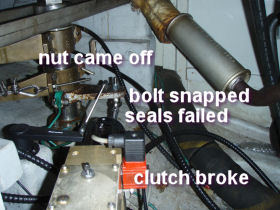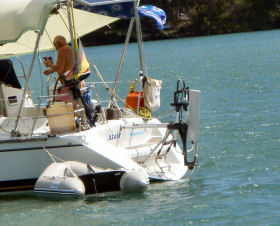Prepping/buying a boat for world cruising.
I feel I'm well placed to write about this now. Maybe even authoritative. Most people will be writing of their experiences on their boat. As a boat bum I've sailed numerous yachts long distance. I've seen every world cruising idea, from a boat with no sea cocks to a production Beneteau with few concessions for world cruising.
1. The essentials.
The essentials. are water, food, power, dinghy and helming. The first three are the obvious ones. Provisioning and water are already mostly obvious to deal with. The dinghy is essential. You WILL be lugging food, yourselves, diesel and water about in yours. Its essential. Power is a complicated business and I'll deal with it last, I've not put fuel in, fuel is wind and chemical fuel diesel, that's just power in another form..
Water
Your yacht, in fact any yacht has a limited capacity for water. Its difficult to change, most people will not try fitting an extra tank. I say have the tanks separate and switch able. In all my sailing experience I've only seen one boat with working water tank gauges. That means by then end of your trip your gauges won't work either.
On water, fit foot pumps or at least one to the main sink. If its practical, fit a salt water foot pump too. Having running salt water in the Galley is great and convenient. Electric systems are well know dangers. If you have a leak or the shower hose hooks the mixer tap (Island Kea II 2007), the electric pump will happily pump all your water into the bilges, or over the side. A salt water pump in the galley makes salt water washing up easy, allows you to cook taters in salt water, instead of salting pasta, a couple of pumps of salt water works well.
Water Makers are notoriously power hungry and expensive. They also require a large amount of baby sitting. Leave them unused they break, pickle them improperly they will never work again. They're lovely, if you can afford the power, and the patience. See power, but an electrically driven one is a no no with out a genny. See the power section.
Food

Bake your own bread
Easy, everyone finds a solution to this. Full meals, pre cooked and frozen, tins. An ARC boat did the Atlantic on camping packets.
Fresh veg! For long trips this should be bought locally as in from a market or similar. It will have to be washed to avoid cockroaches. Refrigerated (supermarket) veg should avoided it will not keep except in a fridge. Onions and potatoes will last a month, Canarian potatoes are particularly recommended.
Fridges and Freezers. These can be lived without. I crossed the Atlantic on a boat with neither. Ultimately they burn power, lots of it. Minimising that power would be my main concern.
Oh and learn how to bake bread!
Dinghy

"Jesus" Tender to Ornen
(because it rose from the dead - sort of)
You will live out of your dinghy, explore with it, shop with it. Carry it up beaches and tie it to docks. Its also the most likely to suffer theft of anything on your boat. Then your going to have to stow it. Don't have one like left, note one person driving one person pumping.
There are 2 basic choices, soft or hard bottomed. Soft are easy to stow, hard are more pleasant. I suspect the some hard core cruisers chop an change. If I had an unlimited budget, I would buy a small soft bottom with a small out board. Then when I got to the Caribbean buy a bigger hard bottom and sell it again before sailing back home. Make it look tatty (so the thieves nick someone else's. Many people don't write their boat name on the dinghy, as they reckon it tell potential thieves when the yacht is empty. This is probably assigning too much sophistication to the criminal mind, I would make mine distinctive with out writing the boat name.
Hard and folding dinghies are still used, and are very nice, drier. If you like to row, then they are great. But stowage is tricky. Rowing a rubber dinghy is miserable, especially the rubber bottomed sort.
An extension to the tiller, can be helpful allowing you to get the weight forward and plane. A stiff piece of pipe and a jubilee clip will do.
Stowage. Davits? Great for the dinghy, in the way for the dock, and swimming. Prevent you having a wind vane. Davits full of dinghy for an ocean passage have caused trouble. Big wave swamps back of boat rips of dinghy and davits, leaving hole in boat. Its a personal thing but I say "no". Hauling it up will be necessary to avoid theft in many places.
Security. Stainless steel chains appear the most popular. Alarms will certainly break eventually. Most people just pad lock the engine on and chain the boat to the dock. In dodgy counties (all of them, if you really like your dinghy) hoist it aboard at night.

Bits of an autopilot that you can Break in 18 Days
Helming
Nobody wants to helm a boat 24 7. Me especially. Some form of autopilot is to my mind essential. They eat power. Many I suspect are not up to the job of world cruising. Downwind sailing is hard on autopilots and rudders. The stories of broken autopilots were 2 to a penny after this years ARC. Carry spares!

Wind vanes, take no power
Wind vanes I love them. Being solely mechanical they're far less likely to break than an autopilot. They consume no power. They do have their foibles. You can't just point the boat where you want and it will steer flawlessly, they need to be used skilfully, some times sacrificing speed for easy helming. I've only ever sailed with a windpilot, an excellent piece of kit. Wind vane's ruin your bathing platform, make dinghy davits impossible etc.
[index]
Power
Ultimately this is going to be your biggest bugbear. All the other essential. bar the dinghy are in some way related to this. When your looking at fridges, water makers, freezers, autopilots. The question must always be "how much power?". A bog standard yacht will have only an engine to charge batteries. Running your engine solely for battery charging will damage it, does damage them. If you have a power hungry boat buy the end of a world cruise you will have seriously deteriorated your engine if you don't keep those charging hours down.
Solar Power these produce relatively little power, a typical panel of 40cm by 80cm will produce about an amp for 8 hours a day, your fridge in comparison may well take 3-5 amps 24 7. Solar panels are not a solution to the problem, but they do help. If (god forbid but it happens a lot) somehow all your batteries are dead. You can't start the engine to charge them. A solar panel will bring your batteries up again eventually, to the point where you can start the engine. I know at least 2 boats who've been saved this way, mentioning no names. If you leave your boat, it will top up and run the bilge pump etc.
Wind Generators these can produce up to 20 amps (the 3 bladed noisy air marine ones), the quieter Rutland type 5 amps tops. many of the arguments for solar apply. However on passage is likely to be your worse time for power. And downwind and rolling is not a good way to get lots of power out of a wind generator.
Towed water generators Slow the boat down by 1/2 knot but produce significant amounts of power. 10 Amps, I've been told, and so longs as your moving they'll produce a lot. I hate slowing boats down, but they work. Sharks love them too by all accounts, biting are not unknown. Carry a spare drogue.
Marine Gensets. Expensive, but far more diesel efficient than the engine. The 're performance is dependent on the charger. Island Kea II had one, and very thoughtfully, they'd got a watermaker too, running off 220Volts. The Generator outputs far more than the charger can use. The watermaker takes lots of power. So they ran the watermaker almost for free, off the excess generator power.
Garden Generators. 1kw or similar petrol generators. I've seen a few of these. They need to be carted onto the deck and faffed with, but they do work, and they'll run your charger easy. If you've got the space the make a good backup system. I suspect they're pretty affordable too. I once experiences a one cylinder, air cooled, 2 stroke diesel one of these - t'was dreadfully noisy and smoky not recommended.
Battery Capacity. The more battery capacity you have the longer it takes to discharge, however this is not usually matched by a proportional increase in the charger, or the alternator. So it means you'll have to spend longer charging them as well. So long as you can run for 24 hours, with the autopilot fridge and nav lights that's enough.
Ultimately, If I were planning a world cruise, I'd want a 3 pronged strategy.
- Minimise the amount the boat needs. Try and reduce the amount of power your going to use. Don't buy a gadget, without looking at its power. Try and insulate fridges better, so that during the night, when they'll not be opened, they can be switched off.
- Diversify. Some sort of renewable source, to keep your services topped up. A wind generator and a solar panel, will nearly keep pace with a fridge in daylight. Try and make it so that when your ashore drinking and touring, you boat is self sufficient, or it will ruin your evening battery charging.
- Discipline. Don't run stuff you don't need, I reckon entertainments like telly's, lights at night etc should not be sacrificed to the god of conservation of AmpHours. But don't run all your lights, just what you need. You won't go in the fridge or freezer at night, providing they're well insulated turn them off!
Power Saving/Charging Gizmos.
Chargers. Pretty much all modern battery chargers are "clever", yours is too. However there's little point in fitting a marine genny, or larger capacity batteries when you've a 25 Amp charger.
Alternators. You can get clever alternator systems too, and its no doubt that they do improve battery charging times. Most car an boat alternators go on for ever! I cannot say the same for the nobby ones, they do go wrong more often. One of the ones that went wrong on me had the option of re-wiring the alternator back to dumb. A good feature.
LED's Light Emitting Diodes. These turn all the electricity you put into them into light (unlike a normal bulb that outputs mostly heat), they never wear out and they're cheap. OK the LED's them selves are cheap, the marinised navlights lights etc are NOT. There's no doubt they work, well and reliably. The light can be a harsh colour, but so are florescent the other low power alternative.
Anchoring
This is a new addition to this document. Based on recent experiences. The boat I am on has 55 meters of anchor chain, and a good anchor winch. Its not really enough. The last boat I crossed the pacific on, I didn't at the time this was originally written realise. Had upgraded its anchor winch and carried 80 meters of chain. That's a LOT for a 42 ft Beneteau. I'm writing this on a mooring buoy in Tahaa, French Polynesia. Its 37 meters deep in this "Anchorage", this is not exceptional. The holding's supposed to be good, the bottom fine. But you need a hell of a lot of chain!
I've seen our quite good anchor winch straining to pull up from a 20 meter bottom, enen in the water that's a big load to pull even the slack.
Good Ideas.
Really Long Mooring line. Your going to need a really long line to go around palm trees, to attach to shore in odd places. If something goes wrong with reverse (folding props usually) you can use it to pull yourself in. It saves the cost of hiring it for the Panama canal. You have your own tow line. The uses are endless, as the rope should be.

Coffee Pecolator
Coffee percolator. You know the ones like the one your granny had. The one cup ones that you put water in and coffee powder and stick on the stove. Makes your watch coffee for one almost instantly and tastes better than instant.
Thermos Flask. re-boiling the kettle for 1 person for each watch is gonna drain your gas.
Old non chart plotter GPS. So you've got an all singing all dancing integrated, technocolour raymarine chart plotter radar with slaved display, daylight readable, integrated satellite telly and hal 9000 computer, eating its way through your batteries all along large ocean passages where the chart shows nowt. Turn it off, and put on the old garmin with the bad icons and blocky display and watch your amps drop!
For God's Sake Don't....
Electric heads. They break more, suck less (in the pumping sense of the word). No no no no.
Washing Machines. The only time your going to have enough water and electrisity for the washing machine is in a marina, and they have a laundrette. Case closed. Strip it out and fill the space with beer.
Safety Gear.
Danbouys, life rings, life rafts etc etc. They're off the shelf component and every one has 'em. Nuff said. What you want is not to need any of them. The Idea is not to have to use them.
Harnesses and Jackstays. These I like, there simple safe and used right are prevent you getting into trouble in he first place.. I'm not convinced by the new all singing all dancing water sensing inflating life jacket harness. Lets face it if you go in, most likely it'll be at night on your own on watch. If they haven't found you by the time you stop swimming they aren't gonna find you. They're bulkier and less comfortable than harnesses, so your more likely to take it off. The expensive ones we used in the Atlantic went off in wet weather, which was irritating.
Skin Fittings. Check 'em, double jubilee clip em. Turn 'em on and off regularly to keep them free if your not using one of your heads, turn it off!
Leaving the Cockpit. Its much better you don't in a big swell. Some things can help this. The main one for me is the pole downhaul, your going world cruising and your going be polling the genoa out a lot. Cheap Beaneteaus have downhaul on the deck, led back to the cockpit. So does every race boat on the planet. Most cruisers don't, god knows why? Roller furling and polling out works lovely, providing that every time you roll a bit in or out you don't have to crawl out to the foredeck and adjust the string you tied to a mooring cleat because you don't have a downhaul.
Engine Exhausts. Water up the tail pipe is a very common source of engine damage. Often fatal to the engine. Long distance downwind in large following seas is going to exploit any deficiencies in your exhaust. I have a theory that cats are most at risk. Their small engines are of tern right aft, making for shorter exhausts, and their shoot down a wave and stop then shoot off again sailing must act like a pump on the exhaust. One skipper of mine used to run his engine up every couple of days just for a few minutes. In case water was building up in the exhaust. No idea if this is effective.
The Jury's out.
I'm not convinced by:
Roller furling mains, yes they're easy when they work, but boy do you have to fiddle with them a lot to stop 'em jamming. If I was going to get in trouble, I'd like to be sure of getting my main in.
ParaSailors. This is a spinnaker with a kite surfer stuffed in it. I'm not convinced they're significnaly better than a spinnaker, and they are expensive. I'm thourally convinced that If you can't handle a spinnaker, and helm a spinnaker, you shouldn't buy one. They do have a good snuffer. But you should know how to drop a kite properly before you use one, you should get some training off Thomas, as his tips were very good. Oh and unless you have a cat, don't set it without the spinnaker pole. The exception to all the above is cruising cats. They don't go dead downwind well. The wide hulls make the parasailor ideal for them you can strap it down tighter than a kite to either hull and point DEAD downwind and boldly point where no cat was supposed to point.